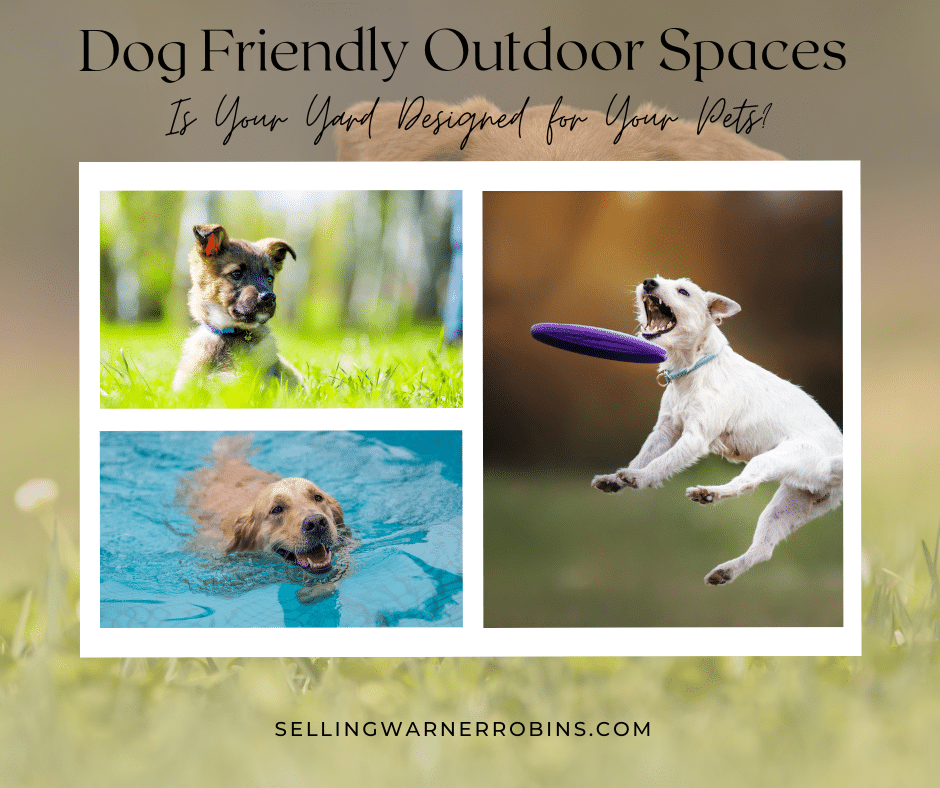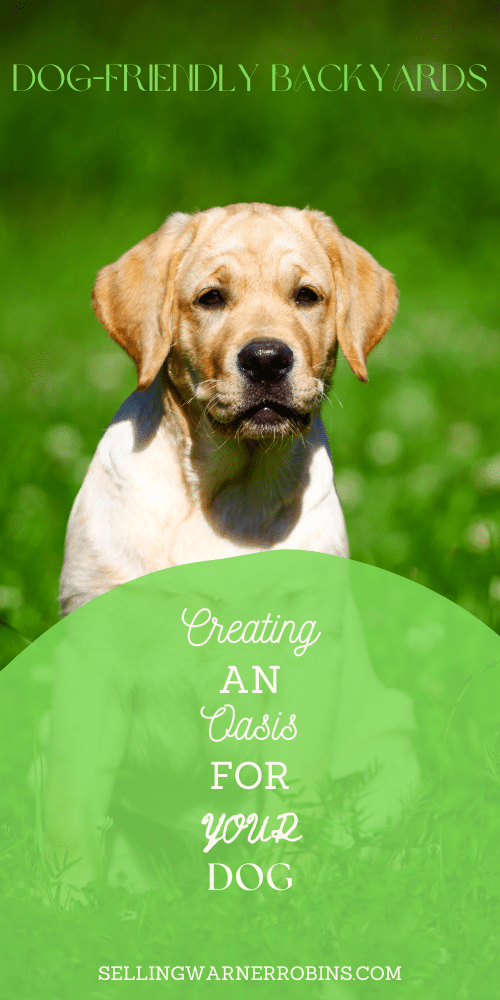Dog-Friendly Outdoor Spaces: Designing Yards for Furry Family Members
Your pets are an essential member of the family, and for your family to be healthy and happy, you need to meet some of their basic needs, which will help them grow well. As a dog owner, you must provide your four-legged friend with stimulating activities that promote a warm temperament in a safe space. This is why creating dog friendly outdoor spaces in your yard becomes essential. Ideally, the space should be aesthetically pleasing and functional for all, human and canine alike.
Creating this sort of harmony requires a lot of planning and careful execution to be functional in any-sized backyard space you have. You need to create a balance that allows you to host guests, have a garden space, and a section where dogs can be free to play, rest, and replenish their energy in seamless synergy. Check out these dog friendly outdoor space ideas to create an oasis your pets will love!

Why Create a Dog-Friendly Backyard?
Why is this type of endeavor necessary for homeowners to engage in? Often, life gets in the way and our pets are not our main focus (shocking, I know!). The goal is to be a responsible pet owner, despite the curveballs that life throws at you.
- Moving homes: Sometimes relocation is necessary for the family, and the space you settle on may not always suit dogs to coexist with landscaping efforts you have in mind.
- Busy Life: As an owner, you may be experiencing a busy life, be it work or other essential responsibilities and commitments that you need to prioritize. This may make it so that you cannot frequently take your pets out to get exercise.
- Safety Concerns: The current area where you live can be dangerous for dogs to trek outside the house perimeter. This protects them from traffic, toxic plants, or escape routes. Creating a safe home space gives owners peace of mind and freedom for dogs.
- Responsible Ownership: A dog-friendly yard makes it easier for dogs to meet their needs and prevent behavioral problems.
- Physical Health: Dogs require regular exercise to maintain a healthy weight and overall fitness. Allowing your dogs to run and burn off energy may not be feasible, but it is essential to prevent obesity and related health issues.
- Mental Stimulation: Creating outdoor spaces for dogs can provide them with opportunities to use their senses and provide mental stimulation. Boredom can often lead to dogs engaging in destructive behavior.
- Stress and Emotional Well-being: Providing access to nature allows dogs to engage in natural behavior, which will help them feel less anxious.
The needs of your dogs:
When creating a dog-friendly backyard, you must consider their needs and find ways to stimulate a positive growth experience that will keep them happy and healthy. When planning your outdoor space, consider your dog’s need for exercise, areas to explore and cool off, and opportunities to engage in natural behaviors safely. When creating this space, consider your dog’s personality and make adaptations based on whether your dog likes digging, patrolling, or chewing items.
Observe your dog’s routines and preferences to inform your landscaping decisions better.
- Exercise and Play: Include agility features like tunnels, balance beams, or obstacle courses.
- Safe Exploration and Boundaries: Create spaces where dogs can run and explore freely.
- Shade Access: Shade can include suitable trees or structures that can help them cool off when the weather is too warm.
- Toileting Areas: Section off an area for them to relieve themselves. Include good drainage in this area to protect the rest of your yard.
- Secure fences and boundaries: This prevents your pets from being triggered by outside stimuli.
- Plant Selection: Include plants that can withstand rough playing from dogs while ensuring they won’t harm their health.
- Maintenance: Opt for structures that are easy to clean and include resilient surfaces.
- Designated Areas: Create clear spaces for dogs and humans to interact together and spaces that keep them separate.
Design ideas For Your Pet Friendly Outdoor Space
The goal of your efforts would be to create dog-friendly zones in a stylish garden, providing a creative solution to common pain points that pet owners experience. The key is to balance play, relaxation, and beauty for the whole family.
Fun ideas to include in your outdoor design
- Create a sensory garden for dogs by including dog-safe grass and aromatic herbs to create a snuffle mat. This will help stimulate their senses and help keep them away from garden beds.
- Making specially created dig pits and sandboxes for dogs can help satisfy their natural instincts without messing up the lawn and flowerbeds.
- Installing designated dog paths and patrol routes using pavers, gravel, or smooth stone on areas that your dog frequents will help prevent areas in your garden and lawn from getting worn out.
- Create water features that are dog-friendly. These can be a kiddie or splash pool that is shallow and dog-friendly. This will be a fun spot for them to enjoy water or to cool off when the weather is hotter. It is important to remember that dogs tend to perspire through their feet, so being able to step into shallow water on hot days can help them regulate their body temperature.
- Use temporary fencing to create dog-run enclosures. This can help keep them away from sensitive garden areas and provide them with spaces to run free without you having to commit to permanent fencing structures.
- Consider using low-maintenance ground covers that are durable instead of traditional grass. Options like Irish moss or stonecrop are tough, yet gentle on paws.
- Artificial grass is another viable option; these turfs have built-in drainage and UV protection, they are often easier to clean, and are great in terms of resisting odors and discoloration over time.
- Raised platforms with a ramp can be suitable if you have an older dog; this ramp will provide comfort for them if they enjoy surveying territory. They can easily have a suitable vantage point while staying comfortable.
- Shaded rest areas in low and accessible areas that are in corners that are shaded. Add dog beds or moss for the areas for your pet to feel comfortable during their downtime.
- Enrichment Zones with brain games like hiding treats and toys among dog-safe plants can encourage them to forage and play, which mentally stimulates them healthily and safely while outside.
Outdoor Space Challenges and Considerations
Naturally, there are some factors that you need to keep in consideration to preserve the space and help you make suitable choices for your landscaping efforts.
- Digging and destruction: Dogs like to dig and forage. When creating your garden, you need to ensure that the plants you choose are safe in the event that your dogs get into them.
- Spots for urination: Creating designated areas is important, as PH levels in their urine can affect patches of grass.
- Safe and durable surfaces: This is to prevent wear and tear, and be easy to clean in case your furry friend treks mud around.
- Secure Boundaries: You want to keep dogs away from outdoor kitchen areas, as this can lead to them getting into the garbage and consuming items that are not healthy for them. Items like plastic, broken glass, sharp objects, meat bones, and remnants of lobster shells left over from grilling outside can end up hurting the animal if they chew on them.
Breaking Down Materials When Building Up Your Outdoor Space
These are materials you can consider using for your dog-friendly backyard ideas.
Fencing:
Dog-friendly fencing will ensure that your dog is confined safely while still being aesthetically appealing for your landscape.
Fencing Materials
- Chain link fencing: affordable, durable, but not visually appealing. And if a dog is determined, they may be able to climb over it or dig under it. If you have short-haired dogs, this is a great option as their fur won’t get caught in the links as well, and the dogs won’t aggressively dig under it or climb over it.
- Vinyl Panel Fencing: Provides protection, and it is easier to maintain as opposed to wooden options. The density of this material will create an effective barrier against distractions from outside the property, which can trigger your dog to bark or run.
- Wood fencing is great for privacy and security, but unfortunately requires more maintenance to keep in pristine condition. If your dog has a tendency to react to visual triggers outside the yard, then a solid wood fence can prevent fence-fighting and barking at people walking past.
Layouts
Double fencing allows you to keep your dogs in specific spaces of the yard. Keep decorative spaces separate from areas where your dog can play. You can protect decorative spaces while giving your dog room to play.
Ground Cover and Plants
You want to choose ground cover options that are both durable and aesthetically pleasing and can be easily maintained.
Resilient ground cover
- Creepy Thyme: This needs to be grown from starts, not seeds. It’s an aromatic ground cover and shows resilience to dogs trekking on it after it is fully rooted.
- Grass: Grass is practical for active dogs. Bermudagrass is exceptionally resistant to both weed growth and pet urine. Consider using specialized seed mixes for challenging areas, high-traffic, or dog park environments.
- Labrador Violet: This is resilient as a ground cover and has purple-green leaves with spring colors that will help with the garden’s aesthetic. This option tolerates both foot traffic and can handle some dog urine while remaining non-toxic.
- Lily Turf: This low-maintenance option adapts to different lighting options and supports pet activity. This plant has a sturdy grass appearance and purple flower spikes
- Ornamental grasses have a root system that stabilizes soil in high-activity areas. They add structure and movement to the landscape and are resilient to dogs walking and playing on them.
Mulch
- Use pine bark, cedar, fir bark, and cypress to provide a comfortable surface for dogs.
- Coconut-based mulch is a pet-friendly alternative that is gentle on paws.
- For smaller areas, you can use pea gravel, which is great for drainage and easy to clean. It serves as a type of kitty litter, but for dogs instead.
Plants
Dog-safe plants and hedges can provide privacy while being safe for animals.
- For hedges, you want to create an effective boundary that will be safe for your dog if they want to have a nibble on the plant. You can use options like camellia, osmanthus, shrub rose, fringe flowers, arborvitae, cypress, and pyracantha.
- Flowers that are dog safe are marigolds, sage, and roses.
- It is best to avoid toxic plants like lilies, hydrangeas, and irises.
Activity Zones
These are areas where dogs can play happily.
Digging Areas
This is an instinctive behavior for dogs, and if you want to preserve your landscaping efforts and gardens, designating areas for dogs to dig can be beneficial.
- Using a sandbox is a great way to highlight a spot for a dog to dig. You can create one using a simple wooden frame and add clean sand.
- Another idea would be to use a plastic kiddie pool and repurpose it as a sandpit.
- Using a kid’s sandbox shell will have the same effect; it will be more useful for smaller dogs that play outside.
- For more elaborate zones, you can create a customized sand pit with digging zones where you can bury toys and treats, to encourage the pets to use this area instead of digging up the gardens.
- To preserve the sandbox and prevent nighttime critters from using it as a litter box, you can use a cover to protect it.
Running Paths and Play Spaces
By keeping your dog’s natural movement patterns in mind, you can create a suitable and thoughtful design that offers the best of both worlds.
- Circular or Oval Paths: Placed around central features like gardens or fire pits, they allow your dogs to engage in high-energy running bursts while still being protective of the decorative elements in your gardens.
- Paths should be a sufficient width to ensure that dogs can move around them comfortably. Opt for 36 inches, as it is an ideal width.
- Planting Pockets: This breaks up the space and preserves areas for dogs to play quietly. Adding pathways between planting pockets and using strategically placed shrubbery can help guide dogs around specific routes.
- If you have energetic dogs, creating an agility course with factors like jump bars, weave poles, and teeter-totters can provide them with mental and physical stimulation.
Cooking Outdoors with Pets
Cooking outdoors near where your pets play can be an enjoyable experience while spending time with your furry friends. However, it is important to prioritize the safety of your pets and not expose them to ingredients that are harmful to them.
- Grilling: In addition to your BBQ-basted hamburgers and lightly buttered lobsters on the grill, you can add some pet-friendly options without seasoning, like lean meats and vegetables.
- Campfire Cooking: While cooking around the campfire and roasting yourself some marshmallows, remember to bring along some treats that can be warmed up over the fire too.
- Picnics: When having a picnic in your backyard, create a dog-friendly basket of treats for your pet, so they can enjoy the experience with you.
Maintenance
- For longevity and overall health, conduct regular check-ups on the designated pet area.
- Regular maintenance and cleaning will keep this area in tip-top condition.
- Watch for pest infestations or potential hazards, and prioritize their removal.
- Consider your pet’s needs during the different seasons, and make adjustments to ensure their comfort and safety.
Is Your Outdoor Space Dog Friendly?
Creating a dog friendly outdoor space boasts several benefits for all members of your family. Tailoring the environment to your dog’s needs will allow them to grow healthy in a fun, safe, and mentally stimulating environment. Before you begin, it is important to note your dog’s habits to personalize their space. Also, be sure to look into materials and items that may be toxic and omit them from your efforts.
If you found this article on dog friendly outdoor spaces helpful, please share the article so more consumers can benefit from the information provided.
About Anita Clark Realtor
Anita Clark has written 687 posts on this blog.
by Anita Clark Anita is a residential Real Estate Agent in Warner Robins Georgia, with Coldwell Banker Access Realty (478) 953-8595, aiding buyers and sellers with all their real estate questions on her Warner Robins blog.



